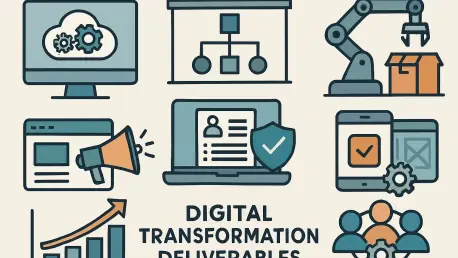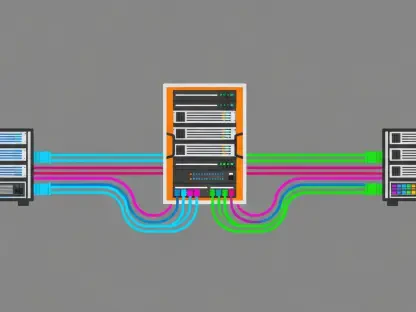In today’s fast-paced business landscape, digital transformation has become a cornerstone for organizations aiming to stay competitive, leveraging technology to revolutionize operations and deliver unprecedented value. However, the journey from vision to reality is fraught with challenges, as countless initiatives stumble over issues like fragmented data, employee pushback, or misaligned objectives. Statistics paint a stark picture: a significant percentage of digital projects fail to meet expectations due to poor planning and execution. The secret to overcoming these hurdles lies not just in adopting advanced tools but in grounding projects with well-defined deliverables that address specific pain points. This exploration delves into the critical role of key deliverables, illustrating how they act as navigational aids in the complex terrain of digital transformation, ensuring that technology investments yield tangible results across industries.
Laying the Groundwork for Digital Shifts
Digital transformation projects are far more intricate than standard IT upgrades, demanding a structured approach to manage their multifaceted nature. Deliverables serve as essential building blocks, providing clarity and direction amid the chaos of technological and organizational change. These targeted outputs help break down monumental tasks into manageable components, addressing everything from data systems to cultural adaptation. Particularly in sectors like engineering, where precision is paramount, deliverables ensure that each step of the transformation aligns with overarching goals. By establishing clear milestones, they enable teams to track progress, identify gaps, and adjust strategies proactively, fostering a disciplined path to success.
Beyond their role as mere tools, deliverables embody a commitment to tackling the unique challenges of digital initiatives. They bridge the gap between abstract aspirations and concrete outcomes, ensuring that every aspect of a project—whether technical or human-centric—receives due attention. For instance, in environments where legacy systems dominate, deliverables offer a framework to modernize without losing sight of operational continuity. Their structured nature helps mitigate the risk of derailment, which is all too common when organizations rush into transformation without a roadmap. Ultimately, they transform ambitious ideas into actionable plans, setting the stage for meaningful progress.
Data Strategies as the Core of Innovation
At the epicenter of any digital transformation lies data, the lifeblood that fuels insights and efficiencies. A data integration strategy stands out as a pivotal deliverable, outlining how disparate data sources can be unified to support advanced analytics and streamlined workflows. Whether opting for a comprehensive data lakehouse to maximize analytical depth or a more straightforward cross-reference table for simplicity, this strategy ensures that information becomes a powerful asset rather than a liability. Without a cohesive approach to integration, organizations risk operating in silos, missing out on the synergies that digital tools promise. This deliverable lays a critical foundation, enabling data-driven decision-making across all levels.
Equally vital is the data quality strategy, which confronts the often dismal state of existing datasets. Legacy systems frequently harbor inconsistencies that can undermine new technologies if left unchecked. By defining acceptable quality standards and outlining steps for enhancement, this deliverable ensures that transformed systems rest on reliable data. It’s not just about cleaning up; it’s about establishing processes to maintain quality over time, preventing future degradation. This focus on data integrity directly impacts the success of digital initiatives, as flawed inputs inevitably lead to flawed outputs. Together, these data-centric deliverables create a robust base for innovation, safeguarding the potential of technological investments.
Precision and Accountability in Execution
Data migration, a cornerstone of many digital projects, is notoriously prone to errors that can jeopardize entire initiatives. The data conversion testing strategy emerges as a crucial deliverable, employing automation and rigorous statistical analysis to validate data integrity during transfers. This approach minimizes the risk of issues like mismatched records or lost information, which can disrupt operations and erode trust in new systems. By systematically identifying and addressing errors before they escalate, this deliverable ensures that migrated data remains accurate and usable. It’s a labor-intensive process, but one that pays dividends by preventing costly setbacks in the long run.
Complementing this is the role of data conversion reports, which provide a transparent overview of the migration process. These reports detail successes, such as the number of records successfully transferred, as well as challenges, like unresolved data conflicts that require further attention. They serve as a critical feedback mechanism, informing stakeholders of progress and pinpointing areas for improvement. Such transparency fosters accountability, ensuring that issues aren’t swept under the rug but are addressed promptly. Together, these deliverables uphold precision in execution, offering both a safety net and a lens into the health of data-driven transformation efforts.
Safeguarding Against Project Pitfalls
Digital transformation projects are inherently complex, often teetering on the edge of failure due to a myriad of risks. A risk assessment deliverable plays an indispensable role by identifying potential obstacles early, from technical glitches to unrealistic scope expectations or overreliance on emerging technologies like AI. By mapping out these hazards and proposing mitigation strategies, this deliverable acts as a preemptive strike against derailment. It ensures that project teams aren’t caught off guard by predictable issues, allowing for contingency plans that keep initiatives on course. This proactive stance is essential in an environment where delays or missteps can inflate costs dramatically.
Moreover, risk assessment goes beyond mere identification; it prioritizes issues based on their potential impact, guiding resource allocation to where it’s needed most. For example, addressing data degradation might take precedence over less critical software compatibility concerns, ensuring efficient use of time and budget. This deliverable also fosters a culture of vigilance, encouraging teams to anticipate rather than react to problems. In doing so, it protects the vision of transformation, preserving momentum even when challenges arise. By embedding risk management into the project framework, organizations can navigate the turbulent waters of digital change with greater confidence.
Addressing the Human Element of Change
Technology may drive digital transformation, but its success ultimately hinges on people adopting and adapting to new systems. The change management plan stands as a vital deliverable, focusing on preparing employees for the shifts that accompany digital initiatives. Through structured training, clear communication, and active stakeholder engagement, this plan addresses potential resistance, particularly in fields where traditional methods are deeply ingrained. It ensures that end-users, such as engineers accustomed to legacy processes, understand the benefits of new tools and feel supported throughout the transition. This human-centric approach is often the difference between a project that thrives and one that stalls.
Additionally, the change management plan establishes timelines and feedback loops to monitor adoption rates and address concerns in real time. It recognizes that transformation isn’t a one-time event but an ongoing process requiring continuous reinforcement. By fostering a sense of ownership among employees, it turns potential skeptics into advocates for change. This deliverable also aligns leadership and staff around shared goals, minimizing friction and building a cohesive effort toward digital goals. Neglecting this aspect can lead to widespread disengagement, underscoring why prioritizing the human side is non-negotiable for lasting success.
Building a Unified Path to Digital Triumph
Reflecting on the journey of digital transformation, it’s evident that the deliverables discussed—spanning data integration, quality assurance, testing, risk mitigation, change management, and conversion reporting—form a comprehensive toolkit for navigating complexity. Each plays a distinct yet interconnected role in addressing the technical precision, operational risks, and cultural shifts that define past projects. Their careful orchestration proved instrumental in turning ambitious digital visions into tangible achievements, ensuring that technology served as a true enabler of progress.
Looking ahead, organizations must commit to embedding these deliverables into future initiatives, recognizing that success demands more than just cutting-edge tools—it requires meticulous planning and execution. Prioritizing data integrity, proactive risk strategies, and employee readiness will remain critical steps in unlocking innovation. By adopting this holistic framework, businesses can confidently tackle the evolving challenges of digital landscapes, transforming potential obstacles into stepping stones for sustained growth and efficiency.









